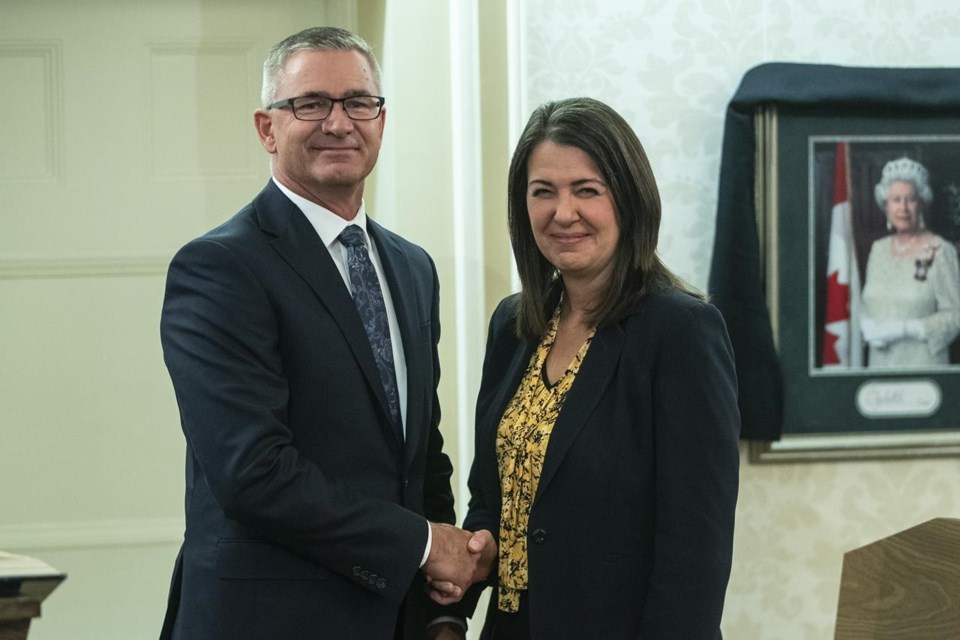EDMONTON — Alberta is revising down this year’s budget bottom line as it doles out inflation-fighting payouts but still expects to finish with a petro-powered $12.3-billion surplus.
“Our fiscal situation has improved substantially,” Finance Minister Travis Toews said Thursday as he released the mid-year update for the 2022-23 budget.
“Challenges are ahead, but we’re leaving no one behind.
“We’re able to provide significant help to Albertans and their families, to keep more money in their pockets for groceries, gas, utilities and other rising costs of day-to-day living.”
The plan is to put the bulk of the windfall into debt repayment, reducing the taxpayer-supported debt by $13.3 billion to a new total of just under $80 billion when the fiscal year ends on March 31.
The government has also set aside $2.8 billion over the next three years to cover a batch of inflation-fighting programs and payouts to shield Albertans — particularly families, seniors and the vulnerable — from higher costs due to inflation spikes.
Premier Danielle Smith announced the payouts and rebates this week while building on existing relief measures that began in the spring under former premier Jason Kenney.
Among the changes, the province has paused its 13 cents a litre tax on gasoline at the pumps and is rebating $50 a month on household electricity bills.
Smith’s United Conservative Party government is re-indexing personal income tax brackets and benefit payments to seniors and people with disabilities — the same programs it de-indexed three years ago.
Middle- and lower-income families with children under 18 will be getting $600 total per child over six months starting in January.
The same $600 benefit will go to middle-income seniors and those in need.
Alberta has a rebate program in place in case heating prices spike, but the trigger point is not expected to be reached at least through to the end of this year.
Opposition NDP finance critic Shannon Phillips said while the province is flush with cash, Smith's government is failing to use it wisely.
Phillips noted the province is not committed to funding the overburdened health system at a rate to match population growth plus inflation. She said many deserving Albertans have been frozen out of the $600-per-person aid package.
On top of that, she said the province had to abandon a previous pledge to put $1.7 billion into the Heritage Savings Trust Fund to pay for the inflation-fighting package, although Toews said no final decisions have been made on that.
"This plan is poorly thought out, it is frantic, it misses a wide swath of Albertans, and it doesn't come anywhere near undoing all the damage they (the government) have authored themselves," said Phillips.
Non-renewable resources are expected to bring in $28.1 billion, with revenue from the oilsands alone making up 70 per cent of that windfall.
Total revenue is pegged at $76.9 billion and total spending at $64.6 billion.
Spending is up slightly to cover big-ticket items such as $174 million in a new pay deal for physicians.
Personal income taxes is to take in $13.3 billion and there will be $6.3 billion in corporate income taxes.
Total spending on COVID-19 and an economic recovery plan are estimated at $2 billion.
The long-term outlook looks bright. Real GDP growth is pegged at 4.8 per cent this year and Alberta is welcoming 22,000 more people — the biggest net migration among all provinces and the biggest influx to Alberta since 2014.
Inflationary pressures have receded but remain a concern, says the government’s outlook. Headline inflation — the raw figure that includes such volatile price swings as gasoline and food — is predicted to be 6.3 per cent this year.
“Volatility in the market is extreme, and that’s why we must continue to make smart, responsible budgetary choices,” Toews said.
It has been a vertiginous ride for Alberta’s resource-reliant economy. In February, as the global economy reawakened from a two-year COVID-19-induced hibernation, Toews tabled a budget forecasting a modest $511-million surplus after years of multibillion-dollar deficits.
But as global demand for oil shot up and Russia invaded Ukraine, putting more strain on energy supplies, the benchmark West Texas Intermediate oil price went through the roof, averaging more than US$100 a barrel for months.
In August, Alberta’s budget surplus was revised from $511 million to $13.2 billion before being revised yet again Thursday to $12.3 billion.
The West Texas price has softened somewhat and is expected to remain as such in the near future, but still hovers in the very healthy $80 a barrel range.
The government says the WTI needs to average out no lower than $81.50 a barrel the rest of the way in order to meet its budget targets.
This report by The Canadian Press was first published Nov. 24, 2022.
Dean Bennett, The Canadian Press



